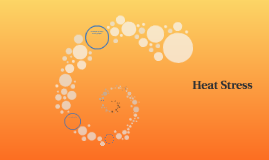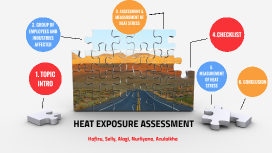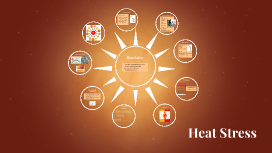HEAT STRESS
Transcript: D. Difficulty in remaining hydrated. B. Skin hotness. C. Significant sweating. C. He has heat exhaustion. C. High body temperature (40 c). THANK YOU Young or old age. 1. Young and old age people are at increased risk of suffering from heat stress due to: A. Lack of information. B. Diseases. C. Medications. D. Difficulty in remaining hydrated. Summary Medications Heatstroke is a medical emergency. Even with immediate treatment, it can be life-threatening or result in serious complications. The first thing do is to call an ambulance, then follow the first aid steps: Types Heat stroke results from prolonged exposure to high temperatures usually in combination with dehydration . Definition of heat stroke is a core body temperature greater than 105 degrees Fahrenheit (40 C) – the hall mark - , that occur after exposure to high temperatures. It is a medical emergency . صصًص Heat cramps are the intermittent, involuntary spasm of muscles that occur in an individual who is physically active in hot or humid weather. It affects the major muscles that are being stressed in the hot environment. *Heat cramps are the earliest symptoms of the spectrum of heat-related illness. Some of the difference between By Ashwaq Asiri Joud Al-Darsoni Randa bin Madi Buthainah Al-Shathri Sara Al-Khelb Sara Al-Mutairi Noir Al-Dosari Nora Al-Refayi Symptoms Heat Stroke Stay out of the sun during the hottest parts of the day, particularly 11am-3pm. If you can't avoid strenuous activity in hot weather, follow the same precautions and rest frequently in a cool spot. Try to schedule exercise or physical labor for cooler parts of the day, such as early morning or evening. If you feel your abilities start to diminish, stop activity and seek out a cool shaded place. Taking breaks or Work-rest cycles give the body an opportunity to get rid of excess heat, slow down the production of internal body heat, and provide greater blood flow to the skin. 5. What is the hall mark symptom that appears in heat stroke: A. Nausea and vomiting. B. Rapid weak pulse. C. High body temperature (40 c). D. Flushed dry Children Advance Symptoms -Significant sweating - Involuntary spasm of the large muscles in the body *When any other symptoms happened, individuals may suffer from heat exhaustion. Get acclimatized Heat Stress Stop all activity and rest Move to a cooler place Drink cool water or sports drinks Remove any tight or unnecessary clothing. Take a cool shower, bath, or sponge bath. Apply other cooling measures such as fans or ice towels. Situations that require exertion in hot weather. is a heat-related illness that can occur after you've been exposed to high temperatures for several days and have become dehydrated. Check the person's rectal temperature and try to reduce it to (39 C) -If a child has stopped breathing, begin rescue breathing Questions Time Drink plenty of fluids to replace fluids lost during sweating. So, Staying hydrated will help your body sweat and maintain a normal body temperature. Drink BEFORE you are thirsty. Replace lost electrolytes such as sodium, potassium and magnesium with food or a sports drink. Eat cold foods, such as salad and fruit, which have a high water content. Do not drink alcohol or beverages with caffeine. become dehydrated Dehydration A lack of air conditioning. Sudden exposure to hot weather Genetic response to heat stress. Lack of information Heat exhaustion 3. Which one of the following is a symptom of heat cramps: A. Headache. B. Nausea and vomiting. C. Significant sweating. D. Fever. Prevention About Heat Stroke 2. Which one of the following is an immediate skin reaction after sun overexposure: A. Skin Blisters. B. Skin hotness. C. Skin peeling. D. Scars. Heat stroke is also known as sunstroke, thermic fever. It is the last stage of Heat stress. It is the most serious form of heat injury and it is a medical emergency that usually follows heat cramps and heat exhaustion. Heat stroke can come on suddenly, but warning symptoms often appear first. Some medications can raise the risk of heat stroke like : Beta blockers - Diuretics . Skin turns red in as little as 30 minutes but most often takes 2 to 6 hours Treatment High body temperature (40C) "The Hall Mark" Wear loose-fitting, lightweight clothing to allow sweat to evaporate. Wear light-colored clothing if you're in the sun. Dark clothing absorbs heat. Wear a hat with a brim to keep the sun off head and face. Use sunscreen to prevent sunburn, which can limit the skin's ability to cool itself. If you are going to work or exercise in hot weather, it's important to acclimatize to the heat for about a week before beginning any intense exercise or work. This allows your body to gradually adapt to the heat. 1-Water depletion; Signs include excessive thirst, weakness, headache, and loss of consciousness. 2-Salt depletion; Signs include nausea and vomiting, frequent muscle cramps, and dizziness. Although heat exhaustion isn't as serious as heat stroke, it isn't something to

















